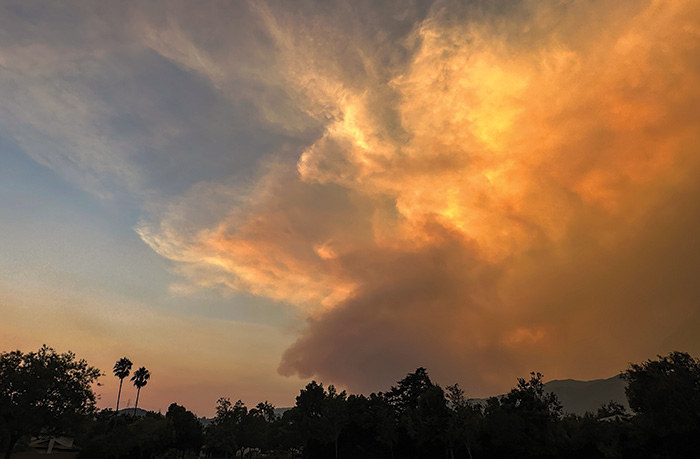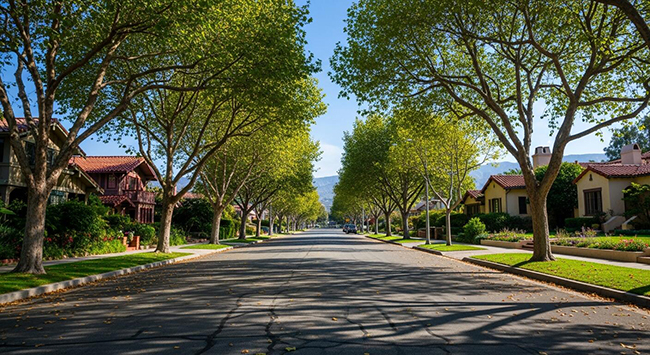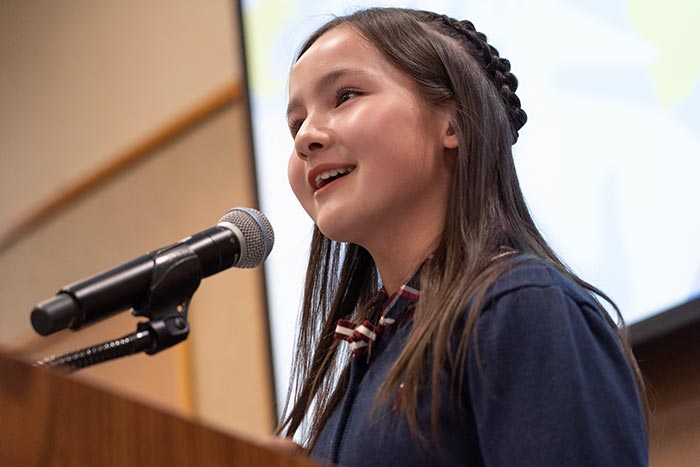Bridge Fire upends plans, life

by Mick Rhodes | editor@claremont-courier.com
As per usual, I wrote most of this week’s column on Monday, spruced it up some Tuesday, and had planned to give it a final edit Wednesday morning before “filing” it, as they say in the newspaper biz.
But this is no per usual week.
I had written about the Bridge Fire from the perspective of the hazards and inconveniences caused by its by-products of smoke, soot, and ash. The gains the fire was making — going from 1,255 acres Monday afternoon to 3,786 24 hours later — were mildly alarming, but fire personnel were holding a perimeter.
All that changed Wednesday morning, when I woke to the news that the Bridge Fire had exploded overnight to nearly 50,000 acres, and was now the largest wildfire burning in the state of California.

Courier photo/Peter Weinberger
A Wednesday morning press conference with state politicians, police, and fire personnel at Santa Fe Dam painted a grim picture: 20 homes lost in the Mt. Baldy area, 13 in Wrightwood, six cabins in the wilderness area, and the power infrastructure in Wrightwood had been damaged.
North Claremont residents were on edge all week as the flames and unbelievably massive plumes of smoke grew closer. They were told by fire officials Wednesday to be prepared to evacuate. Watching the aerial horror show early Wednesday was frightening enough from the safe remove of my Pomona home. The footage and photos I saw from inside the fire in Mt. Baldy, Wrightwood, and elsewhere were absolutely terrifying, reminiscent of a warzone.
About 5 p.m. Wednesday an LA County firefighter working in Mt. Baldy told Courier Publisher Peter Weinberger, who was up there shooting photos, “The goal was to keep the fire from jumping the road into the Village.” As of Wednesday evening, they’d been successful. But great swaths west of Baldy Road were scorched right up to the road.
I awoke Thursday to a chill in the air for what seemed the first time in weeks. It was 55 degrees when I stepped out onto my front porch before sunrise and took my first sip of coffee. The air was still hazy, but my eyes weren’t burning as they had been since Monday. It felt like the Bridge Fire had done its worst, but was now in retreat, or at least limbo. The more than 400 firefighters who had been working around the clock since Sunday had thwarted the Bridge Fire’s advance into Mt. Baldy Village, and best of all, no lives had yet been lost.
I wondered what the folks who lost their homes were going through. I wondered about the wildlife that wasn’t able to stay ahead of the rapidly advancing blaze. And I thought about the perils of living up against the wilderness, like those in north Claremont, and in the case of Mt. Baldy residents, right up in it. These horrific wildfires are increasing, both in frequency and size. What does the future hold for folks like us who live adjacent to their source of fuel?
This feels familiar
The recent scorching heat followed by a wildfire seems to have become a regular feature here, with the past two summers having been much the same. The sky choked with smoke and my stinging eyes have reminded me of what it was like to grow up in this region in the 1970s, with “smog days” at school, and being “smogged out” if we ran around too much in the summer, when it was at its thickest.
Thankfully California attacked the problem scientifically. Soon car manufacturers were required to install cleaner burning engines in their vehicles sold in the state. In a few years we could see the mountains again in the summertime, and California’s clean air initiatives became the model for the country.
Our new normal reminds me of those days. But unlike the 1970s, it’s going to take more than science and a cooperative, forward-thinking legislature to change things. Global warming is a worldwide problem, hence the global bit, and the U.S. is the primary contributor.
Meanwhile, unlike in the 1970s, when the bulk of the legislative measures were taken to combat smog, the science of global warming has become weaponized politically. It will take bold steps from our famously polarized federal government to made headway. It seems like a longshot in today’s environment that anything significant will happen in my lifetime.
Maybe a few more summers of catastrophic wildfires, unhealthy air, and apocalyptic orange sunrises will be enough to shake the tree. We shall see.










0 Comments